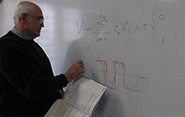New Book Offers Context, Applications for Electrical Engineering Classes

Seventeen years ago, professor of electrical engineering Roman Kuc wrote a book that soon became a standard text for introductory electrical engineering courses—despite the fact that he never intended it to be used that way. His latest book, Electrical Engineering in Context: Smart Devices, Robots, & Communications, goes beyond that earlier book, completely reimagining the text to show electrical engineers how the technology we use on a daily basis, such as our smart phones, is an extension of fundamental electrical engineering concepts.
 The new book began as a revision and significant expansion of Kuc's Digital Information Age. "That earlier book was based on a course I taught here at Yale that had 800 students in one term, the largest course at Yale," he says. "So naturally, I wrote the book intending it for non-science majors. But what happened is the book came out, and professors across the country—at Columbia, at Princeton, at the University of Illinois—started using it as part of the electrical engineering curriculum. Which was embarrassing because it was not intended as an electrical engineering text!"
The new book began as a revision and significant expansion of Kuc's Digital Information Age. "That earlier book was based on a course I taught here at Yale that had 800 students in one term, the largest course at Yale," he says. "So naturally, I wrote the book intending it for non-science majors. But what happened is the book came out, and professors across the country—at Columbia, at Princeton, at the University of Illinois—started using it as part of the electrical engineering curriculum. Which was embarrassing because it was not intended as an electrical engineering text!"
But Kuc understood the appeal. In his course and in others based on his text, students and professors had fun using the book, and the students could immediately apply what they learned about electrical engineering to real-world technologies. "The professors would be able to say here's a barcode, here's how you do encryption, here's how you serve multiple users simultaneously—and then they'd talk about orthogonal signals," he says. "The context gave you a reason to talk about the science."
 With so many advancements since its original publication, Kuc's publisher decided to issue an updated second edition of Digital Information Age, with changes that would reflect how the book was being used. For example, while reviewers praised the book's format, they wanted more theory and concepts, such as discussions of Ohm's law, Kirchhoff's law, spectral FFT, and sensors and actuators. "And I put these things in," says Kuc, "and all of a sudden this book started growing from 200 pages to more than 500 pages. Then I said OK, now this is an introductory electrical engineering textbook. It's a whole new book, something unexpected."
With so many advancements since its original publication, Kuc's publisher decided to issue an updated second edition of Digital Information Age, with changes that would reflect how the book was being used. For example, while reviewers praised the book's format, they wanted more theory and concepts, such as discussions of Ohm's law, Kirchhoff's law, spectral FFT, and sensors and actuators. "And I put these things in," says Kuc, "and all of a sudden this book started growing from 200 pages to more than 500 pages. Then I said OK, now this is an introductory electrical engineering textbook. It's a whole new book, something unexpected."
Electrical Engineering in Context, however, keeps the practically and application by integrating MATLAB projects throughout that enable engineering students to pursue their own interests. "So you still learn by doing, by participating in the design process," he says.
And for faculty who do use Digital Information Age in classes for non-science majors? Kuc says not to worry as the planned second edition is still coming out this spring, with exercises that use Excel instead of MATLAB. "My heart is still for the non-science majors," Kuc says. "Everyone needs to know about technology today."

